Fourth Experiment
So though my current goal is light brown, I don't expect this experiment to give that color. What I'm basically doing is finding out what I'm working with. I'm using the same ratio of powder as I did in the last experiment--1:2 henna:indigo--but I'm not using anything to stretch it. Therefore, I'm using enough powders to cover the strand of mohair.
So I gathered, secured, then washed my mohair using cold, filtered water and baking soda. Then I rinsed it with cold, filtered water, and set it on a sheet of Bounty, out of my way.
Then I mixed 1/4t. henna and 1/2t. indigo in a plastic bag, added 1 1/2t. cold, filtered water and 1/8t. ACV.
Yes, I'm using acid. Why? I believe most of the people who used the 1:1 henna:indigo mix to get golden brown in 30 minutes mentioned that it faded. Maybe it was the fact that the water was boiling hot when added to the powders--thereby changing the structure of the dye or how it moves. Or maybe it was the lack of acid. Currently, I'm thinking it was the lack of acid, my husband thinks it could be both. So I want to put that to the test. This may not be the last of such testing.
Anyway, I put the still wet--not dripping wet--strand into the bag, sealed it, and smooshed the mix into it. Then I put it on a sheet of Bounty, which I folded so it was between 8 layers of it. I put this on the hot plate until it was fairly warm--more than lukewarm, nowhere near hot. Lastly, I put it on the PC's system unit, which is about the same temperature as the bag right now.
I left this for 4 hours, rinsed, and the strand is very...green. I was hoping I could have avoided having to wait for oxidization, but apparently not. There are some parts that aren't so green, and the brown seems lighter than I expected, so hopefully, this will turn out really well.
So here it is after rinsing and on the third day after.
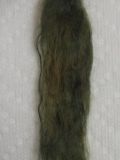
Though it's looking better, I don't think it turned out well. And I'm thinking indigo really does mute henna. At least it was still a learning experience. Please don't try this one, ever.
Fifth Experiment
So, since my last experiment was a failure, I'm going to try a new approach. The same ratio, but in a 2-step method. I was inspired by the ladies whose gray/white hair just refused to hold the color from the 1-step. And I figure the reason you get black with henna then indigo is because of the high dye saturation. And then someone mentioned using henna, then indigo+amla. I already feel amla strips henna, so I consider that to be using half as much henna (if so much), and then the indigo is diluted by amla. So I'm keeping the 1:2 henna:indigo ratio, but using cassia to help make it a 2-step method.
So I worked some mohair into a strand, secured it, and washed it in lukewarm, filtered water and baking soda. Then I rinsed it in cold, filtered water and set it on a sheet of Bounty.
Then I put 1/4t. henna and 1/2t. cassia in a plastic bag and added 1 1/2t. cold, filtered water to it. I mixed that well, then put the still wet strand into the bag, and sealed it.
I put the bag on a sheet of Bounty, then folded it so the bag was between 8 layers of it. I put that on the PC's system unit which was slightly warmer than lukewarm.
I checked it after 45 minutes. The bag was lukewarm, and I noticed dye release. so I left it for 3 more hours, for a total of 3 hours and 45 minutes. Then I rinsed it well in lukewarm, filtered water, and set it aside on a sheet of Bounty.
Then I put 1/2t. indigo and 1/4t. cassia in a plastic bag, added 1 1/2t. lukewarm, filtered water, and mixed it well. Then I put the still wet strand in the bag, sealed it, and put it back in the folded sheet of Bounty, back on the PC's system unit for 3 hours.
I rinsed the strand in lukewarm, filtered water. It had a little yellow-green cast at first, but it's oxidizing quickly. There's still some green, but I'm certain that will be gone within the first couple days.
So here it is.
And here it's compared to the blond strand from experiment #3.
And finally, here it is next to my jet black hair.
Sixth Experiment
So, I realized that I'd forgotten two very important things I wanted to try. First, I wanted to test the addition of oil to the henna paste.
So I grabbed some mohair, worked it into a strand, secured it, and set it aside.
Then I got a plastic bag and mixed 1t. henna with 2t. cold, filtered water. Then I added 1/8t. coconut oil. I chose this amount because this is the ratio I use in my own hair--1/8 as much oil as henna powder. So anyway, I mixed it well again, and I must say the consistency of the henna was just lovely and silken at this point.
So I washed the strand with cold, filtered water and baking soda, rinsed it in cold, filtered water, squeezed out most of the excess water, and put it in the bag. I then sealed the bag and worked the paste into the strand.
I put the bag between 8 layers of a folded sheet of Bounty, and set it on the PC's system unit (which is still just barely warmer than lukewarm).
I left it for 6 hours, then rinsed it. The color looks like that of the strand from the first experiment. I see absolutely no difference.
So I conclude that coconut oil, at least in this ratio, has no effect on dye uptake.



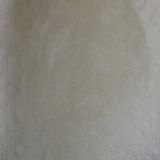
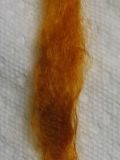
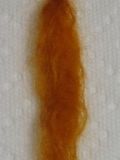
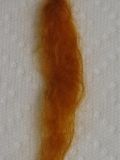
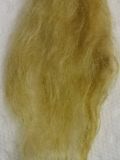
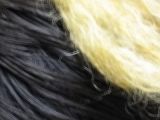
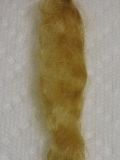


 Reply With Quote
Reply With Quote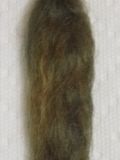
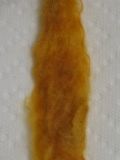
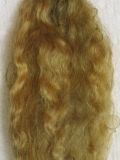
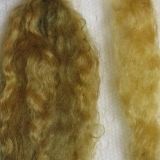
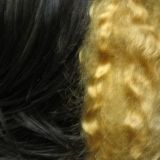
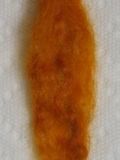
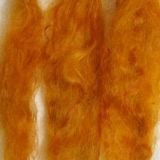
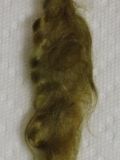
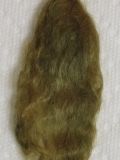
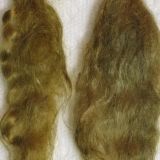





 Zift, I'm sure it would. My hair is too dark to bother with indigo and I like my few grays being orange.
Zift, I'm sure it would. My hair is too dark to bother with indigo and I like my few grays being orange. 




Bookmarks